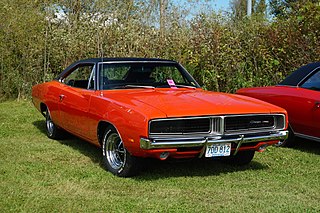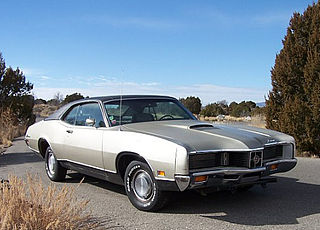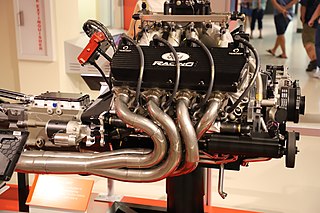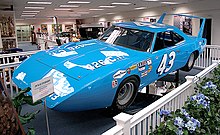
Stock car racing is a form of automobile racing run on oval tracks and road courses measuring approximately 0.25 to 2.66 miles. It originally used production-model cars, hence the name "stock car", but is now run using cars specifically built for racing. It originated in the southern United States; its largest governing body is NASCAR. Its NASCAR Cup Series is the premier top-level series of professional stock car racing. Australia, Canada, New Zealand, Mexico, Brazil, Argentina, and the United Kingdom also have forms of stock car racing. Top-level races typically range between 200 and 600 miles in length.

The Plymouth Road Runner is a mid-size car with a focus on performance built by Plymouth in the United States between 1968 and 1980. By 1968, some of the original muscle cars were moving away from their roots as relatively cheap, fast cars as they gained features and increased in price. Plymouth developed the Road Runner to market a lower-priced, basic trim model to its upscale GTX.

The Plymouth Superbird is a highly modified, short-lived version of the Plymouth Road Runner with applied graphic images as well as a distinctive horn sound both referencing the popular Looney Tunes cartoon character the Road Runner. It was the factory's follow-up stock car racing design, for the 1970 season, to the Dodge Charger Daytona of 1969, and incorporated many engineering changes and modifications garnered from the Daytona's season in competition.

The Dodge Charger is a model of automobile marketed by Dodge in various forms over eight generations since 1966.

The Dodge Challenger is the name of three different generations of automobiles produced by the American automobile manufacturer Dodge. However, the first use of the Challenger name by Dodge dates back to 1959 for marketing a "value version" of the full-sized Coronet Silver Challenger.

The Ford Torino Talladega is a muscle car that was produced by Ford only during the first few weeks of 1969. It was named for the Talladega Superspeedway, which opened the same year. The Talladega was a special, more aerodynamic version of the Torino / Fairlane produced specifically to make Ford even more competitive in NASCAR racing, and it was sold to the public only because homologation rules required a certain minimum number of cars be produced and made available.

Dodge produced three separate models with the name Dodge Charger Daytona, all of which were modified Dodge Chargers. The name was taken from Daytona Beach, Florida, which was an early center for auto racing and still hosts the Daytona 500, NASCAR's premier event. The original Dodge Charger Daytona was designed to beat the competition in NASCAR racing. It was the first NASCAR vehicle to reach 200 miles per hour, which was a major milestone at the time.
The B platform or B-body was the name of two of Chrysler's midsize passenger car platforms – at first rear-wheel drive, from 1962 through 1979; and the later, unrelated front-wheel drive platform, used by the Eagle Premier / Dodge Monaco, from 1988 through 1992.

The Dodge Magnum is a nameplate used by several Dodge vehicles, at different times and on various markets. The name was first applied to a large Chrysler B platform-based 2-door coupe marketed from 1978 to 1979 sold in the United States and Canada. From the 2005 to the 2008 model years, the nameplate was revived for a Charger-based station wagon on the rear-wheel drive Chrysler LX platform, produced in Canada and sold on the American and Canadian market.

The Dodge Charger (1966), also known as Dodge Charger (B-body), is a mid-size automobile that was produced by Dodge from 1966 through 1978 model years, and was based on the Chrysler B platform.

The Mercury Cyclone is an automobile that was marketed by the Mercury division of Ford from 1964 to 1971. Introduced in 1964 as the Mercury Comet Cyclone, the Cyclone replaced the S-22 as the performance-oriented version of the Mercury Comet model line. The Cyclone became a distinct nameplate for the 1968 model year, as the Mercury Montego was phased in to replace the Comet.
Car and Track was America's first nationally syndicated auto racing and car test television show. The executive producer for car and track productions was, John B Norman of Grand Rapids Michigan. "Big Bud Linneman filmed and MC the show. His son Dave drove the cars at a little-known track outside Grand Rapids Michigan, Grattan. The show aired on Saturday mornings normally and the ongoing sponsor was Casite automotive additives based in Hastings Michigan. John Norman owned an advertising agency in Grand Rapids and this was the basis for Executive Producers the production company. Executive producers also had an office in Los Angeles California. Norman would arrange with automakers to receive cars to test at the track and Grattan. Produced by Car and Track Productions, it was hosted and produced by Bud Lindemann, a famous race commentator of the time. After the TV series ended, Bud and his son David Lindemmann continued to film many types of racing. They compiled one of the most important film libraries of the early days of NASCAR. Car and Track was based in Grand Rapids, Michigan. This allowed them to have close relationships with Detroit automotive manufacturers and suppliers.
American Muscle Car is a weekly television show on Speed, produced by Restoration Productions LLC., about muscle cars. Original release was in 2003. Each episode provides a timeline of each vehicle's history beginning with its first year of production to its most recent year of production. The show was initially designed to showcase traditional muscle cars such as the Chevrolet Camaro, Ford Mustang, and Dodge Charger. It eventually added other performance vehicles such as the Shelby Cobra and the, and even began to focus on specific eras such as the (disambiguation)|. In 2006 season, the show's focus was expanded to include designers and engineers of muscle car era.

The 1970 Daytona 500 was a NASCAR Grand National Series race held on February 22, 1970, at Daytona International Speedway in Daytona Beach, Florida.

The 1971 Daytona 500, the 13th running of the event, was a NASCAR Winston Cup Series race held on February 14, 1971 at Daytona International Speedway in Daytona Beach, Florida. Spanning 500 miles (800 km) on the paved oval track, it was the first Daytona 500 in the Winston Cup era of NASCAR. During this time, Richard Petty was becoming one of the winningest veterans on the NASCAR circuit.
This article documents the events that occurred in motorsports in the 1960s.

The Mercury Cyclone Spoiler II is a muscle car that was produced by Mercury in early 1969. The Mercury Cyclone Spoiler II was a special, more aerodynamic version of the Mercury Cyclone. It was produced specifically to compete against the Dodge Charger Daytona and Plymouth Superbird produced by Chrysler, and the nearly identical Ford Torino Talladega, in NASCAR stock car racing, and was sold to the public only because homologation rules required a minimum number of cars be produced and made available for sale to the public. All production examples were constructed during the first few weeks of 1969.

The NASCAR Cup Series is the top racing series of the National Association for Stock Car Auto Racing (NASCAR). The series began in 1949 as the Strictly Stock Division, and from 1950 to 1970 it was known as the Grand National Division. In 1971, when the series began leasing its naming rights to the R. J. Reynolds Tobacco Company, it was referred to as the NASCAR Winston Cup Series (1971–2003). A similar deal was made with Nextel in 2003, and it became the NASCAR Nextel Cup Series (2004–2007). Sprint acquired Nextel in 2005, and in 2008 the series was renamed the NASCAR Sprint Cup Series (2008–2016). In December 2016, it was announced that Monster Energy would become the new title sponsor, and the series was renamed the Monster Energy NASCAR Cup Series (2017–2019). In 2019, NASCAR rejected Monster's offer to extend the naming rights deal beyond the end of the season. NASCAR subsequently announced its move to a new tiered sponsorship model beginning with the 2020 season similar to other U.S. based professional sports leagues, where it was simply known as the NASCAR Cup Series, with the sponsors of the series being called Premier Partners. The four Premier Partners are Busch Beer, Coca-Cola, GEICO, and Xfinity.

The Generation 2 in NASCAR refers to the cars used between 1967 and 1980. The second generation of stock cars featured stock body with a modified frame, and modified chassis became part of the sport with entities such as Holman-Moody, Banjo Matthews, and Hutchenson-Pagan building chassis for teams.

NASCAR, the highest governing body and top level division for stock car racing in the United States, has used a range of different types of engine configurations and displacements since its inaugural season in 1949. The engines are currently used in the Cup Series, Xfinity Series, Camping World Truck Series, and the Whelen Modified Tour.

















